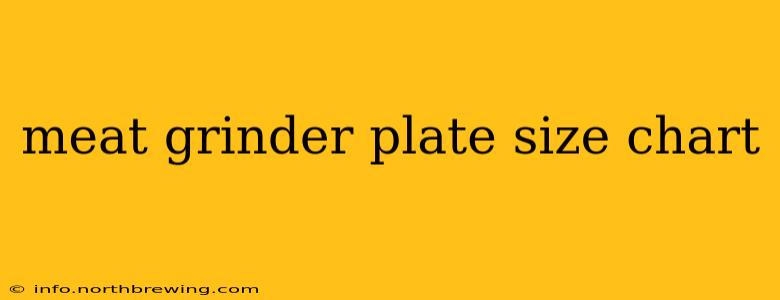Choosing the right meat grinder plate can significantly impact the texture and consistency of your ground meat. This comprehensive guide will help you understand meat grinder plate sizes, their applications, and how to select the perfect plate for your needs. Whether you're a seasoned home cook or a butcher, this chart and accompanying information will prove invaluable.
What are Meat Grinder Plates and Why are Different Sizes Important?
Meat grinder plates, also known as grinding plates or die plates, are the essential components that determine the final particle size of your ground meat. They're perforated metal discs that sit within the grinder's head, dictating the size of the holes through which the meat is forced. Different sized holes create different textures: coarser for sausages, finer for burger patties.
The size of the plate is usually measured in millimeters (mm) or sometimes as a numbered system specific to the manufacturer. A smaller number indicates smaller holes and finer ground meat. A larger number means larger holes and a coarser grind.
Understanding Meat Grinder Plate Size Charts (and Why They Vary)
Unfortunately, there isn't one universal meat grinder plate size chart. The sizing and numbering system can vary significantly between manufacturers (like LEM, Cabela's, Weston, etc.). This is why it's crucial to refer to the manufacturer's specific chart that came with your meat grinder or is available on their website. Generic charts you find online might not be accurate for your specific model.
That said, we can still discuss general principles:
Common Plate Sizes and Their Uses:
While precise measurements vary, here's a general guideline based on common plate hole sizes:
-
3mm (or equivalent): This produces a medium grind, suitable for many applications, including burgers, meatballs, and some sausages. It's often a versatile all-purpose choice.
-
4.5mm - 6mm (or equivalent): These are coarser grinds, ideal for sausage making (especially coarser sausages like bratwurst) where a larger meat particle is desired for texture. They might also be useful for grinding tougher cuts of meat where a coarser grind helps facilitate processing.
-
Fine Plates (less than 3mm): These are used for extremely fine grinds, often used for things like pate or forcemeats. They require more power from your grinder and are more likely to clog.
-
Very Coarse Plates (greater than 6mm): These are used for coarse grinding, often as a first pass to break down tougher meats or very large chunks before finer grinding.
How to Choose the Right Meat Grinder Plate
The best plate size for you will depend on your intended use:
What kind of meat are you grinding?
Tougher cuts of meat may benefit from a coarser grind first, followed by a finer grind. More tender meats can be ground directly with a finer plate.
What are you making?
- Burgers: Typically require a medium to fine grind (3mm or finer).
- Meatballs: Medium to fine.
- Sausages: Often benefit from a medium to coarse grind, depending on the type of sausage. Italian sausage, for example, may prefer a finer grind than bratwurst.
- Pates and Forcemeats: These require very fine grinds.
What is the capacity of your meat grinder?
Some smaller grinders might struggle with finer plates or larger quantities of meat. Always refer to your grinder's manual for recommendations.
Frequently Asked Questions (FAQ)
Can I use any meat grinder plate with any meat grinder?
No. Meat grinder plates are specifically designed to fit certain models. Using an incompatible plate can damage your grinder or lead to injury. Always use the plates recommended by the manufacturer for your specific model.
How do I clean my meat grinder plates?
Most meat grinder plates are dishwasher safe, but hand washing with warm, soapy water is also effective. Make sure to thoroughly clean all crevices to prevent bacteria growth.
Where can I buy replacement meat grinder plates?
Replacement plates are usually available from the manufacturer's website or through kitchen supply stores and online retailers that carry parts for your specific grinder brand. Always specify your grinder model number when ordering replacements.
What if my meat grinder is clogging?
Clogging often means you need to use a coarser plate or that your meat is too cold (cold meat is harder to grind). Ensure your grinder is properly assembled and that the meat is fed consistently into the hopper.
By understanding the specifics of your meat grinder and following the manufacturer’s recommendations, you can ensure consistent, high-quality ground meat every time. Remember to always prioritize safety and consult your user manual for detailed instructions and safety precautions.
